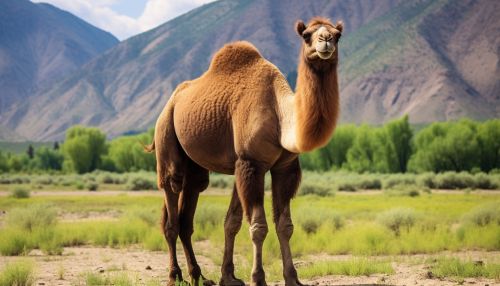Camelus bactrianus
Taxonomy and Naming
The Bactrian camel, scientifically known as Camelus bactrianus, is a large mammal native to the steppes of Central Asia. It is named for the historical region of Bactria in Central Asia. The Bactrian camel belongs to the genus Camelus, which also includes the dromedary camel and the wild Bactrian camel. The term "Bactrian" is derived from the ancient region of Bactria, where the camel was first domesticated.


Description
The Bactrian camel is distinguished by its two humps, which are used to store fat that can be converted into water and energy when sustenance is not available. These humps give the Bactrian camel an ability to endure long periods of travel without water, in harsh desert conditions. Adult Bactrian camels typically stand at 1.85 m (6 ft 1 in) at the shoulder, with a body length of 2.15 m (7 ft 1 in) to 3.5 m (11 ft 6 in). Males are generally larger and heavier than females.
Habitat and Distribution
Bactrian camels are native to the Gobi Desert in Mongolia and Xinjiang in China. They are well adapted to the harsh desert conditions, with wide, tough feet that can withstand the hot sand and sharp rocks. They are also able to withstand extreme temperatures, from the freezing cold winters to the scorching hot summers.
Diet
Bactrian camels are herbivores, with a diet consisting mainly of grasses and leaves. They are also known to eat thorns, dry vegetation, and salty plants that other animals would avoid. This ability to consume a wide variety of vegetation allows them to survive in their harsh desert environment.
Behavior and Lifestyle
Bactrian camels are social animals, typically found in groups called herds. These herds are usually led by a single dominant male, with the rest of the group consisting of females and their young. Bactrian camels are known for their endurance and ability to travel long distances, making them ideal for transportation in the desert regions they inhabit.
Reproduction
The mating season for Bactrian camels occurs annually, during which the dominant male will mate with the females in his herd. After a gestation period of approximately 13 months, the female will give birth to a single calf. The calf is able to walk and run within a few hours of birth, a crucial survival trait in the harsh desert environment.
Conservation Status
The Bactrian camel is currently listed as critically endangered on the IUCN Red List due to hunting and habitat loss. There are currently estimated to be less than 1,000 wild Bactrian camels left in the world. Conservation efforts are being made to protect and preserve this unique species.
